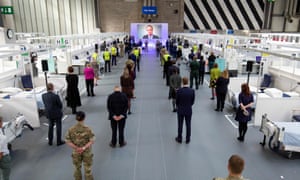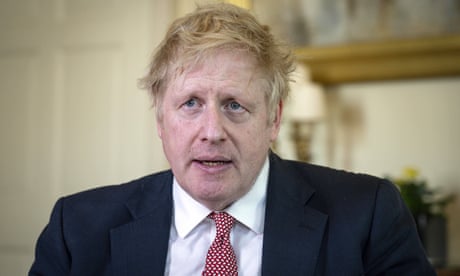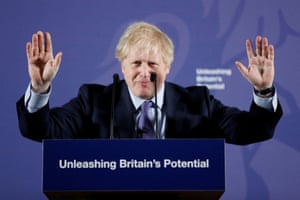How did Britain get its coronavirus response so wrong?
ANOTHER RIGHT WING GOVERNMENT BLOWS IT
As the warnings grew louder, Boris Johnson’s government was distracted by Brexit. On testing, contact tracing and equipment supply, there was a failure to prepare

Britain’s health secretary, Matt Hancock, speaks via video link during the official opening of the NHS Nightingale hospital in Birmingham. Photograph: Jacob King/AFP via Getty Images
LOOKING LIKE BIG BROTHER AS ORWELL IMAGINED AS WELL AS MICHAEL MOORE V FOR VENDETTA AND APPLE 1984
by Toby Helm, Emma Graham-Harrison & Robin McKie Sun 19 Apr 2020
By late December last year, doctors in the central Chinese city of Wuhan were starting to worry about patients quarantined in their hospitals suffering from an unusual type of pneumonia.
As the mystery illness spread in one of China’s major industrial hubs, some tried to warn their colleagues to take extra care at work, because the disease resembled Sars (severe acute respiratory syndrome), the deadly respiratory disease that had killed hundreds of people across the region in 2002-03 after a government cover-up.
One of those who tried to raise the alarm, though only among a few medical school classmates, was a 33-year-old Chinese ophthalmologist, Li Wenliang. Seven people were in isolation at his hospital, he said, and the disease appeared to be a coronavirus, from the same family as Sars.
In early January he was called in by police, reprimanded for “spreading rumours online”, and forced to sign a paper acknowledging his “misdemeanour” and promising not to repeat it.
Many early cases were linked to the city’s Huanan seafood and fresh produce market, which also sold wildlife, suggesting that the first cases were contracted there.

The Wuhan hygiene emergency response team leave the closed Huanan seafood wholesale market on 11 January. Photograph: Noel Celis/AFP via Getty Images
Scientists would discover the disease had probably originated in bats and had then passed through a second species – in all likelihood, but not certainly, pangolins, a type of scaly anteater – before infecting humans.
But the infections were soon spreading directly between patients, so fast that on 23 January the government announced an unprecedented lockdown of Wuhan city and the surrounding Hubei province.
Two weeks later, on 7 February, Li, who had contracted coronavirus himself, died in hospital from the condition about which he had tried to raise the alarm. He had no known underlying conditions and left behind a wife and young child.
Li became the face of the mysterious new disease. The story of his death and pictures of him in a hospital bed wearing an oxygen mask made media headlines across the globe, including in the UK.
The world, it seemed, was slowly becoming more aware of how lethal coronavirus could be, that it was not just another form of flu with fairly mild symptoms.
But while UK scientists and medical researchers were becoming more concerned, and studying the evidence from China, those among them who were most worried were not getting their messages through to high places.
Distracted by Brexit and reshuffles
The Conservative government of Boris Johnson had other more immediate preoccupations at the start of this year.
Johnson was still basking in his general election success last December. After he returned from a celebratory Caribbean holiday with his fiancee, Carrie Symonds, the political weather for the prime minister seemed to be set fair. It was honeymoon time.
Three and a half years on from the Brexit referendum, the UK was finally about to leave the EU on 31 January. The fireworks and parties for the big night were being planned, the celebratory 50p coins minted.
Minds were certainly not on a developing health emergency far away, as Johnson prepared to exploit the moment of the UK’s departure from the European Union for all it was worth. “I think there was some over-confidence,” admitted one very senior Tory last week.
The prime minister and his chief adviser, Dominic Cummings, wanted to make an early impression at home in other ways too, as domestic reformers. Cummings was waging a war on civil servants in Whitehall, throwing his weight around and deliberately upsetting the Westminster applecart.
While he made the headlines, briefing about his iconoclastic ambitions, Johnson was preparing a big Cabinet reshuffle to assert his own authority in other areas now Brexit was done and dusted.
With Labour effectively leaderless after its fourth consecutive election defeat, there was little opposition to trouble Johnson on any front at all – and certainly no-one of note asking tough questions about coronavirus.
The prime minister duly recast his cabinet team on 13 February – five days after Li’s death in Wuhan. He made big changes but unsurprisingly retained the hitherto safe pair of hands of Matt Hancock as his health secretary.
In a sign of where priorities lay – and the lack of concern that a potential crisis might be heading our way from the east – Hancock wasted no time recording a video of himself grinning with delight on reshuffle day.
He smacked his right fist into his left palm saying he could not wait to “get cracking” and that he relished the chance to deliver the Tories’ manifesto promises, reform social care and improve life sciences. And lastly, in a more sombre voice, he spoke of “dealing with coronavirus and keeping the public safe” before adding, as the grin returned: “Now let’s get back to work!”
It is perhaps too early to conclude for sure that Johnson, Hancock and the government’s entire team of scientific and medical advisers were caught asleep at the wheel. But the fact that Johnson and Hancock themselves, in common with much of the Downing Street staff, would go on to contract the virus or suffer symptoms, further suggests that people at the top had not been sufficiently on their guard.
Now, 11 weeks on from the first cases being confirmed in the UK on 31 January – a period during which more than 14,000 people (and probably several thousands more once care home fatalities are counted) in the UK have died from Covid-19 – and with the country in lockdown, the economy facing prolonged recession as a result, schools closed, and no sign of an end in sight – hard questions have to be asked.
We already know with some certainty that other countries, such as Germany, South Korea, Taiwan and New Zealand, will emerge from this crisis having performed far better than the UK. A few weeks ago the government’s advisers crassly said that fewer than 20,000 deaths would be “a very good result” for the UK.

Boris Johnson missed five coronavirus Cobra meetings, Michael Gove says
As we fast approach that grim tally, many experts now believe the UK may come out of this crisis, whenever that may be, with one of the worst records on fighting coronavirus of any European nation. Once the full tally is counted, few expect the number of deaths to be below 20,000.
By contrast, on Friday, Germany was saying it thought it had brought coronavirus largely under control. It had had 3,868 deaths, less a third of the total in the UK (and Germany’s population, at 83 million, is far higher), having conducted widespread testing for Covid-19 from early on, precisely as the UK has failed to do.
How, then, did it come to this? How did coronavirus spread across the globe, prompting different responses in different countries? Did the UK simply fail to heed the warnings? Or did it just decide to take different decisions, while others settled on alternative actions to save lives?
The warnings grow louder
David Nabarro, professor of global health at Imperial College, London, and an envoy for the World Health Organization on Covid-19, says one thing is for sure. All governments were warned how serious the situation was likely to become as early as the end of January. Ignorance of the danger that was coming can be no excuse. Yet it would not be until late March – later than many other countries – that Johnson would announce a complete lockdown.
“WHO had been following the outbreak since the end of December and within a few weeks it called a meeting of its emergency committee to decide if this outbreak was a ‘public health emergency of international concern’,” said Nabarro.
WHO made it very clear – to every country in the world – that we were facing something very serious indeedProf David Nabarro, Imperial College, London
“That is the highest level of alert that WHO can issue, and it issued it on January 30. It made it very clear then – to every country in the world – that we were facing something very serious indeed.”
Well before the end of January, the WHO had been tracking the growing threat minutely: 14 January was a key day in the spread of the disease that would become known as Covid-19. The first case was confirmed outside China, with a woman hospitalised in Thailand.
A WHO official warned then that it was possible that human-to-human transmission had occurred in families of victims – a sign that the disease had potential to spread far and fast – and, inside China, officials were quietly told to prepare for a pandemic.
There was little international attention on the day, though, because Beijing’s dire warnings about a pandemic were made in secret, and a WHO spokesman rowed back from his colleague’s claim.
Officially, China had not seen a new case of the coronavirus for over a week; the outbreak appeared to be fading. It took another six days for China to publicly acknowledge the gravity of the threat, time that scientists believed meant a further 3,000 people were infected.
But on 20 January, officials announced more than 100 new cases and admitted the virus was spreading between humans, a red flag for concern to anyone who works on infectious diseases. The virus could no longer be contained by finding the animal source of the infection and destroying it.
Two days later, the scale of the challenge was made clear to the general public when Beijing locked down millions of people. All transport into and out of the metropolis of Wuhan was cut off, an unprecedented modern quarantine that would come at huge human and economic cost.
On 29 January, the UK would have its first two confirmed cases of the disease. There was little sense that China’s dilemma and its approach – shut down life as we know it or watch the death toll spiral out of control – might have to be our nightmare within weeks.
In early February, Donald Trump announced a ban on travellers who had passed through China in the previous 14 days. Europe began focused testing of people with symptoms and travel histories that linked them to the disease, but little else.
By contrast, on Friday, Germany was saying it thought it had brought coronavirus largely under control. It had had 3,868 deaths, less a third of the total in the UK (and Germany’s population, at 83 million, is far higher), having conducted widespread testing for Covid-19 from early on, precisely as the UK has failed to do.
How, then, did it come to this? How did coronavirus spread across the globe, prompting different responses in different countries? Did the UK simply fail to heed the warnings? Or did it just decide to take different decisions, while others settled on alternative actions to save lives?
The warnings grow louder
David Nabarro, professor of global health at Imperial College, London, and an envoy for the World Health Organization on Covid-19, says one thing is for sure. All governments were warned how serious the situation was likely to become as early as the end of January. Ignorance of the danger that was coming can be no excuse. Yet it would not be until late March – later than many other countries – that Johnson would announce a complete lockdown.
“WHO had been following the outbreak since the end of December and within a few weeks it called a meeting of its emergency committee to decide if this outbreak was a ‘public health emergency of international concern’,” said Nabarro.
WHO made it very clear – to every country in the world – that we were facing something very serious indeedProf David Nabarro, Imperial College, London
“That is the highest level of alert that WHO can issue, and it issued it on January 30. It made it very clear then – to every country in the world – that we were facing something very serious indeed.”
Well before the end of January, the WHO had been tracking the growing threat minutely: 14 January was a key day in the spread of the disease that would become known as Covid-19. The first case was confirmed outside China, with a woman hospitalised in Thailand.
A WHO official warned then that it was possible that human-to-human transmission had occurred in families of victims – a sign that the disease had potential to spread far and fast – and, inside China, officials were quietly told to prepare for a pandemic.
There was little international attention on the day, though, because Beijing’s dire warnings about a pandemic were made in secret, and a WHO spokesman rowed back from his colleague’s claim.
Officially, China had not seen a new case of the coronavirus for over a week; the outbreak appeared to be fading. It took another six days for China to publicly acknowledge the gravity of the threat, time that scientists believed meant a further 3,000 people were infected.
But on 20 January, officials announced more than 100 new cases and admitted the virus was spreading between humans, a red flag for concern to anyone who works on infectious diseases. The virus could no longer be contained by finding the animal source of the infection and destroying it.
Two days later, the scale of the challenge was made clear to the general public when Beijing locked down millions of people. All transport into and out of the metropolis of Wuhan was cut off, an unprecedented modern quarantine that would come at huge human and economic cost.
On 29 January, the UK would have its first two confirmed cases of the disease. There was little sense that China’s dilemma and its approach – shut down life as we know it or watch the death toll spiral out of control – might have to be our nightmare within weeks.
In early February, Donald Trump announced a ban on travellers who had passed through China in the previous 14 days. Europe began focused testing of people with symptoms and travel histories that linked them to the disease, but little else.
---30---

No comments:
Post a Comment